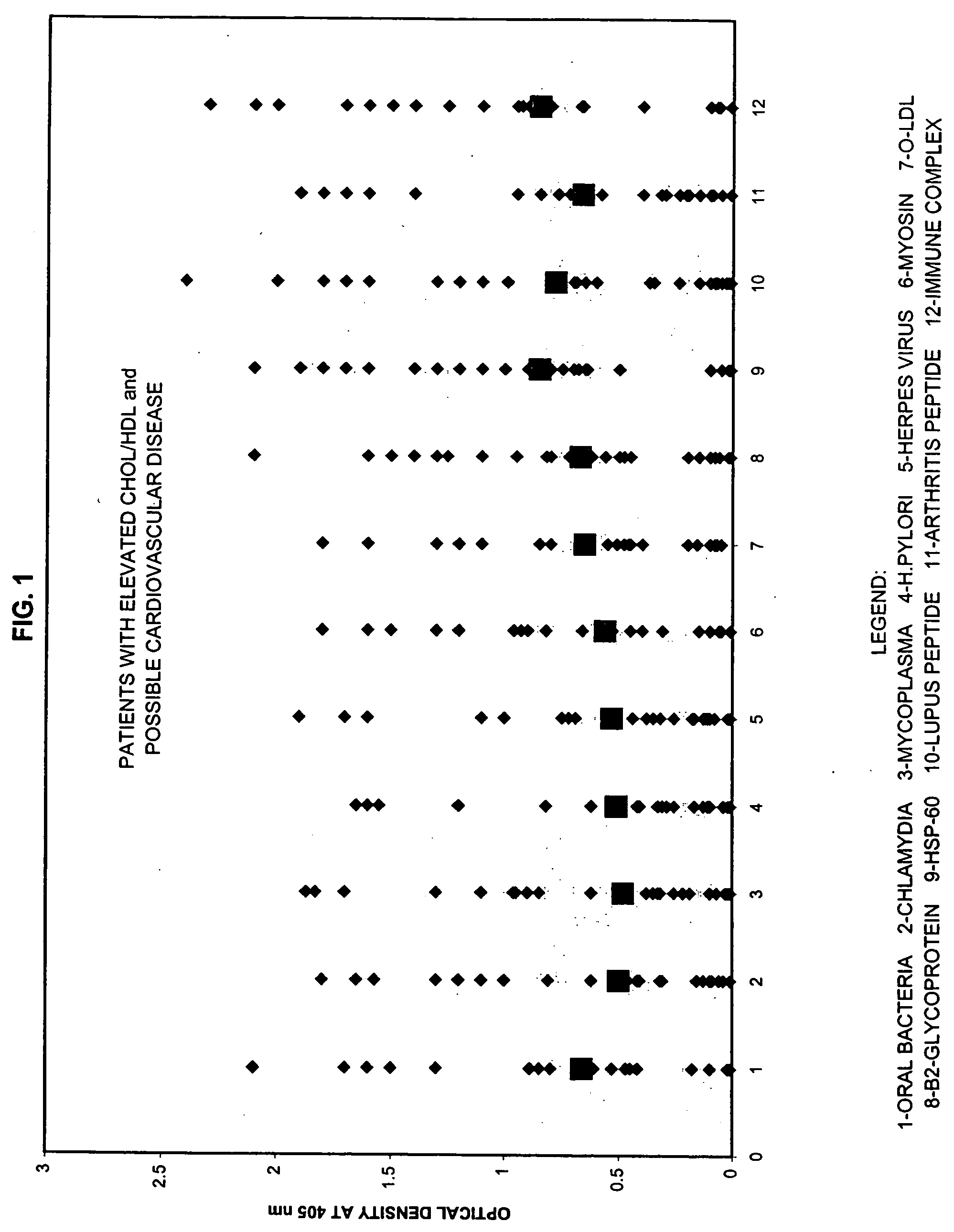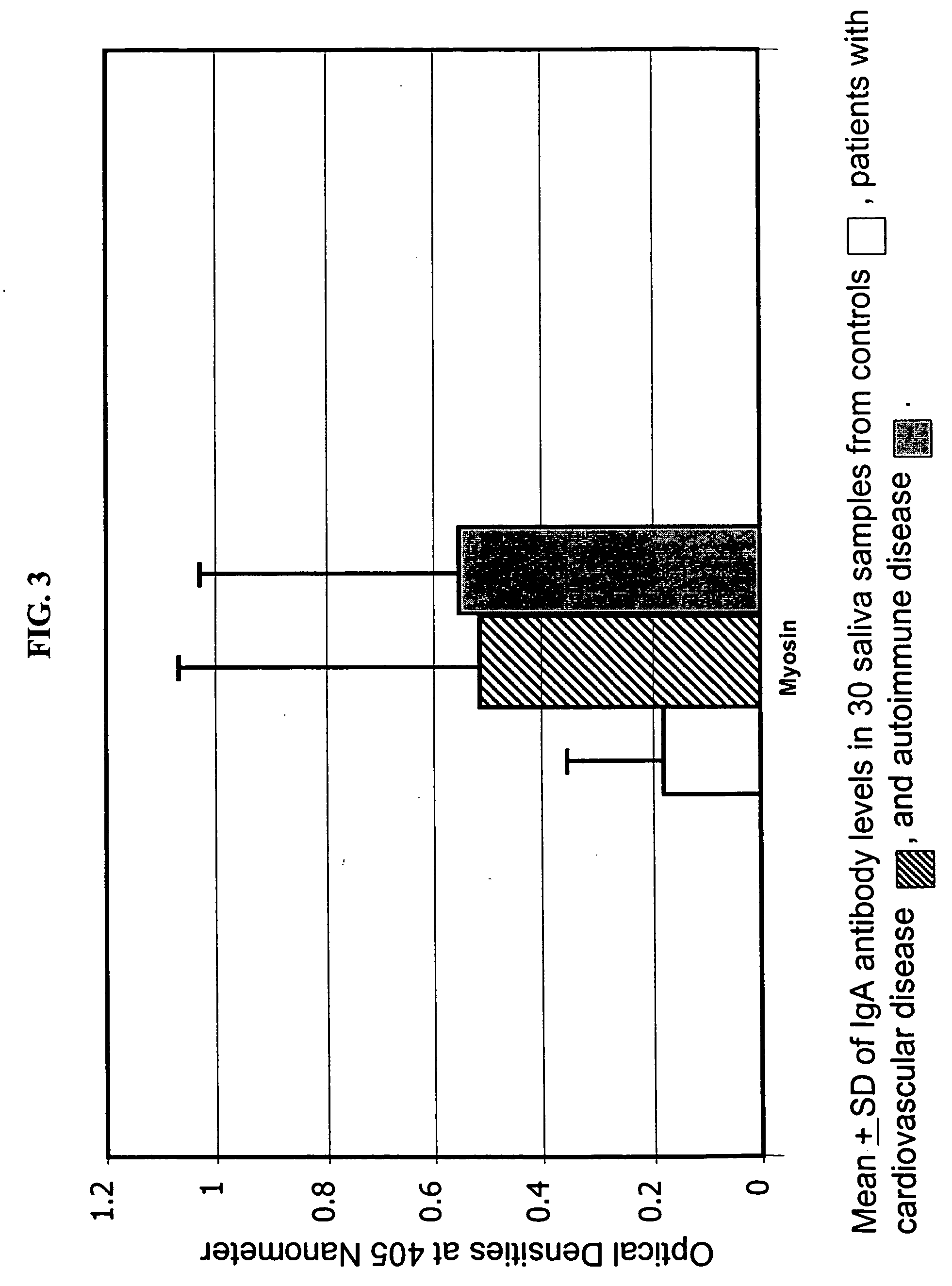Saliva immunoassay for detection of antibodies for cardiovascular disease
a technology of antibody detection and saliva, which is applied in the direction of material analysis, biological material analysis, instruments, etc., can solve the problems of tissue damage, fibrous lesions or plaque formation, and release of tissue antigens
- Summary
- Abstract
- Description
- Claims
- Application Information
AI Technical Summary
Benefits of technology
Problems solved by technology
Method used
Image
Examples
example 1
General Procedures for Immunity Panel for Cardiovascular Disease
[0059] For the test, about 2 ml of patient saliva was collected. Saliva specimen was kept at −20° C. until the performance of the assays.
[0060] The purified antigens were immobilized by attachment to a solid surface, such as a microtiter plate. The saliva sample was added to the plate followed by incubation and washing. Antibody bound to antigen was revealed by adding enzyme labeled monoclonal antibody directed against the first immunoglobulin. After addition of substrate, color development was measured by microtiter reader at 405 nm. The intensity of the color was directly related to the concentration of antibodies to these antigens present in patient's specimen.
[0061] Saliva samples were collected in the morning, before brushing teeth, smoking, or drinking. 2 ml of saliva was collected. Saliva was collected after a gentle chewing action in a test tube containing 0.1 ml of preservative. Saliva specimen was kept at −...
example 2
[0071] Myosin pathogenic peptide “SLKLMATLFSTYASA” was synthesized by a robotic multiple peptide synthesizer and resin was used as solid support. Peptide was characterized by reversed-phase HPLC and electrospray mass-spectrometry with purity greater than 80%. This peptide was bound to bovine serum albumin and used for coating microtiter plates.
[0072] Each well of microtiter plate was coated with 3 μg peptide in 0.1 M carbonate buffer pH 9.5. After 24 hours incubation and washing, 200 ml of 2% BSA was added and incubated for an additional 2 hours. Plates were washed, dried, and used for measurement of myosin antibodies. The test specimen was added to the plate followed by incubation and washing. The procedure in Example 1 was followed to measure for the myosin antibodies.
[0073] The ELISA values for the calibrators used in this test system were as follows: Calibrator I=7.5, Calibrator II=15, and Calibrator III=30.
[0074] The ELISA values for each test specim...
example 3
Test for Oxidized LDL Antibody
[0075] Wells of microtiter polystryrene plate were coated with 3 μg of oLDL in 100 μl of 0.1 M carbonate buffer pH 9.6 and were kept overnight at 4° C. The plates were then washed with PBS and blocked with 2% BSA for 2 hours at room temperature. Plates were washed, dried, and used for detection of antibodies against oLDL. The test specimen was added to the plate followed by incubation and washing. The procedure in Example 1 was followed to measure for oLDL antibodies.
[0076] The ELISA values for the calibrators used in this test system were as follows: Calibrator I=37, Calibrator II=75, Calibrator III=300, and Calibrator IV=1200.
[0077] The ELISA values for each test specimen were determined using the formula in Example 1.
PUM
 Login to View More
Login to View More Abstract
Description
Claims
Application Information
 Login to View More
Login to View More - R&D
- Intellectual Property
- Life Sciences
- Materials
- Tech Scout
- Unparalleled Data Quality
- Higher Quality Content
- 60% Fewer Hallucinations
Browse by: Latest US Patents, China's latest patents, Technical Efficacy Thesaurus, Application Domain, Technology Topic, Popular Technical Reports.
© 2025 PatSnap. All rights reserved.Legal|Privacy policy|Modern Slavery Act Transparency Statement|Sitemap|About US| Contact US: help@patsnap.com



